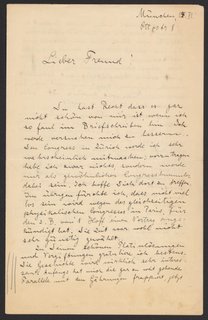Letter from Hans Friedenthal to Georg Bredig
- 1899-Feb-11

Rights
Download all 3 images
PDFZIPof full-sized JPGsDownload selected image
Small JPG1200 x 1802px — 308 KBLarge JPG2880 x 4324px — 1.5 MBFull-sized JPG2956 x 4438px — 1.5 MBOriginal fileTIFF — 2956 x 4438px — 37.6 MBHans Friedenthal (1870-1943), a German physiologist, thanks Georg Bredig (1868-1944) for sending his work on fermentation. Friedenthal describes his understanding of fermentation from a biological perspective and asks further questions about how it is approached in physical chemistry. Friedenthal also mentions that he has sent Bredig some of his scientific works dealing with physical chemistry.
| Property | Value |
|---|---|
| Addressee | |
| Author | |
| Place of creation | |
| Format | |
| Genre | |
| Extent |
|
| Language | |
| Subject | |
| Rights | No Copyright - United States |
| Credit line |
|
| Additional credit |
|
| Digitization funder |
|
Institutional location
| Department | |
|---|---|
| Collection | |
| Series arrangement |
|
| Physical container |
|
View collection guide View in library catalog
Related Items
Cite as
Friedenthal, Hans Wilhelm Carl. “Letter from Hans Friedenthal to Georg Bredig,” February 11, 1899. Papers of Georg and Max Bredig, Box 1, Folder 41. Science History Institute. Philadelphia. https://digital.sciencehistory.org/works/49yptqb.
This citation is automatically generated and may contain errors.
Image 1
Charlottenburg, den 11. II. 99.
Sehr geehrter Herr Dr.!
Nehmen Sie meinen besten Dank für die Absendung Ihrer interessanten Arbeit, die ich mit Sendung einiger meiner Arbeiten beantworte habe, welche das Gebiet der physikalischen Chemie berühren. Trotz der zweifellosen Verwandtschaft zwischen Vorgängen der H2O2 Katalyse und der Wirkung der Verdauungsfermente, habe ich diese doch bisher für Reaktionen sui generis gehalten, und ich jene deshalb noch
Image 2
(page 2)
Ihren werten Vorschlag die Zeit zur Messung der Fermenteinheit zu beachten, bis mein Versuche die genauen Funktion der Fermentmenge ergeben haben werde.
Dürfte ich Sie wohl um die große Freundlichkeit ersuchen, mir zu schreiben, wie die Vorgänge in der physikalischen Chemie gedeutet werden, welche dazu führen, dass die doppelte Platinkonzentration nicht die doppelte Menge H2O2 in gleicher Zeit ersteht, da es mir, der allerdings mit den vertrauten angeführten Vergleichsfunktionen auch nicht sehr vertraut ist, nicht
(page 3)
möglich ist bisher, bei der Fermentwirklungfinsterschaltung der Störungen durch die Zersteckungsprodukte etwas anders mir vorstellen als eine Proportionalität zwischen Wirkungsgeschwindigkeit und Concentration. Sollte letzteres der Fall sein, müsste ich auch die Zahl der umgeänderten Moleküle als das geeignete Maßstab der Messung der Fermentmenge betonen. Mit nochmaligem Danke für die wertvolle Zusendung.
Ergebenst
Dr. Hans Friedenthal
Charlottenburg, Bismarkstrasse 96
Image 1
Charlottenburg, February 11, 1899
Dear Dr. Bredig,
Thank you for sending your interesting work, to which I have responded by sending some of my papers addressing the field of physical chemistry. Despite the undoubted relationship between the processes of H2O2 catalysis and the effect of digestive ferments, I have thus far considered these to be generic reactions.
Image 2
(page 2)
Moreover, I will therefore consider your helpful suggestion to take time to measure the ferment unit until my experiments to determine the exact function of the amount of fermentation conclude.
Could I ask you to kindly let me know in writing how the processes in physical chemistry are interpreted, which conclude that twice the platinum concentration does not produce twice the amount of H2O2 in the same time frame, because I am not familiar with the aforementioned comparison functions?
(page 3)
Hence, it is impossible for me to imagine anything else regarding the disturbances in dark fermentation caused by decomposition products other than a proportionality between the speed of action and the concentration. Should the latter be the case, I should also emphasize the number of altered molecules as the appropriate measurement for the amount of ferment. Thank you again for your valuable shipment.
Sincerely,
Dr. Hans Friedenthal
Charlottenburg, Bismarkstrasse 96







